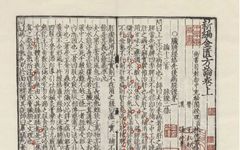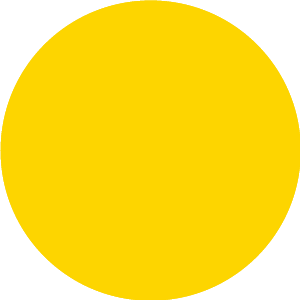
Understand Traditional Chinese Medicine better here, click the blue text to follow us
“Jingui Yaolue”
“Jingui Yaolue” is an important work by Zhang Zhongjing, a revered physician of the Eastern Han Dynasty, and is one of the most significant classical texts in Traditional Chinese Medicine (TCM). It is well-known that “Jingui Yaolue” is an abbreviation (which can also be further abbreviated to “Jingui”), but the full name or “correct name” of this text is something that few people truly understand.
As an important classic, “Jingui Yaolue” should have a definitive name. However, the fact is that its title has been somewhat chaotic throughout history, with several important versions having different names. The currently popular view is that the full name of “Jingui Yaolue” is “Jingui Yaolue Fang Lun”. For example, the “Dictionary of Chinese Medical Literature” lists “Jingui Yaolue Fang Lun” as the correct entry, referring to the book as “abbreviated as ‘Jingui Yaolue’ or ‘Jingui'”; Zhao Faxin and others’ compiled “Dictionary of Chinese Medical Literature” treats it similarly, also using “Jingui Yaolue Fang Lun” as the correct entry; Zhang Canqi’s “Study of Ancient Chinese Medical Literature” refers to the book directly as “Jingui Yaolue Fang Lun” when discussing medical literature from the Han and Three Kingdoms periods; and a publicly available video lecture on “Jingui Yaolue” (by Wang Xuehua from Heilongjiang University of Chinese Medicine) also uses this name, stating that it is called “Fang Lun” because the book contains both formulas and discussions, “using formulas to treat and discussions to explain”… The basic point of agreement among these various interpretations is consistent. So how did these nearly unanimous views come about? It is simple: because in the Ming Dynasty, Zhao Kaimei edited the “Complete Works of Zhongjing”, in which the “Jingui Yaolue” was titled “Jingui Yaolue Fang Lun”. Although there were several other editions with different titles before Zhao Kaimei, the influence of his edition was significant, leading everyone to believe that this title was the correct one.
Due to the lack of materials, it was indeed difficult to clarify the correct name of this book in the past. However, now, some new materials have emerged, allowing us to clarify this issue.
The “new materials” mentioned here refer to two main discoveries: one is the edition of the “Jingui Yaolue” with a preface by Deng Zhen, discovered in the library of Peking University in the 1980s, which is believed by most scholars to belong to the Northern Song Dynasty’s large-character edition and is considered the ancestor of several important later versions of the book, such as the Ming Dynasty’s Yu Qiao edition, Xu Rong edition, and Zhao Kaimei edition; the second is the copy of the Northern Song small-character edition transcribed by Wu Qian in the 28th year of the Hongwu era (1395 AD), discovered in the Shanghai Library in 2007 (this is noted in the Ming edition). The Deng Zhen edition was discovered relatively early and has already attracted scholarly attention, with some university textbooks on “Jingui Yaolue” using the Deng Zhen edition as the base text; however, the Wu Qian edition has received relatively little attention and research so far.
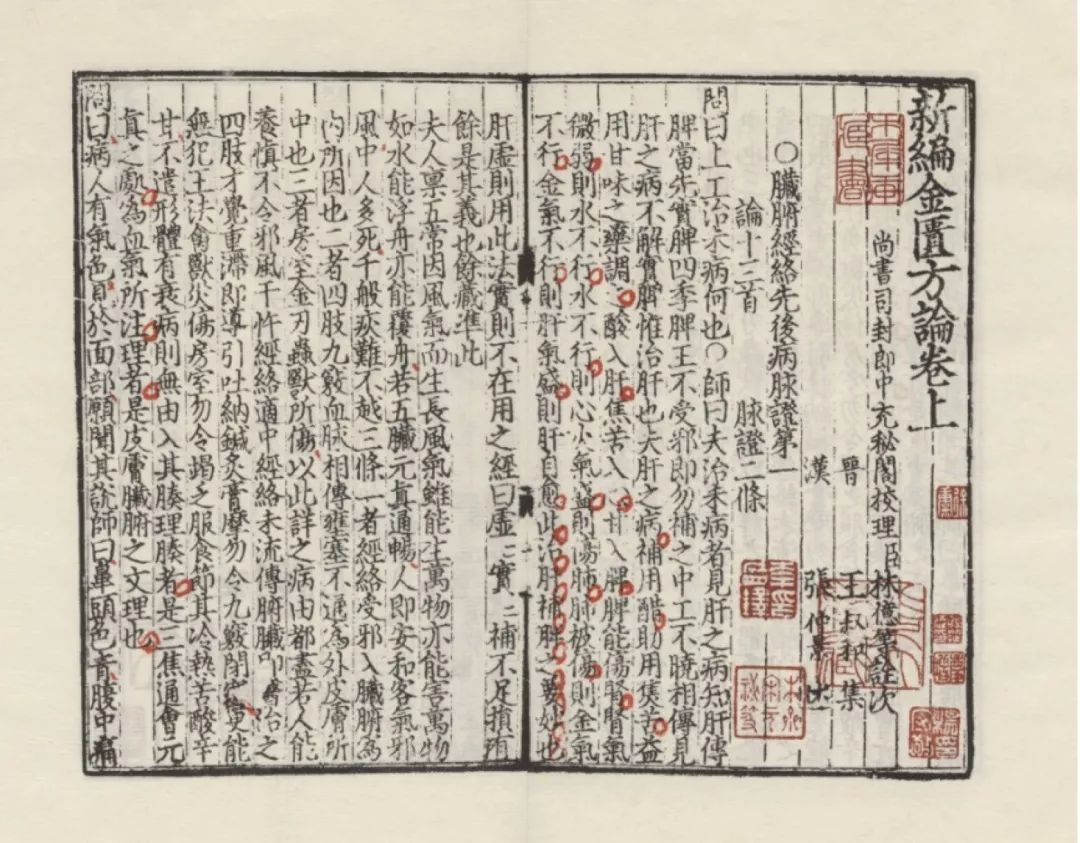
The first page of the Deng Zhen edition of “Jingui Yaolue”
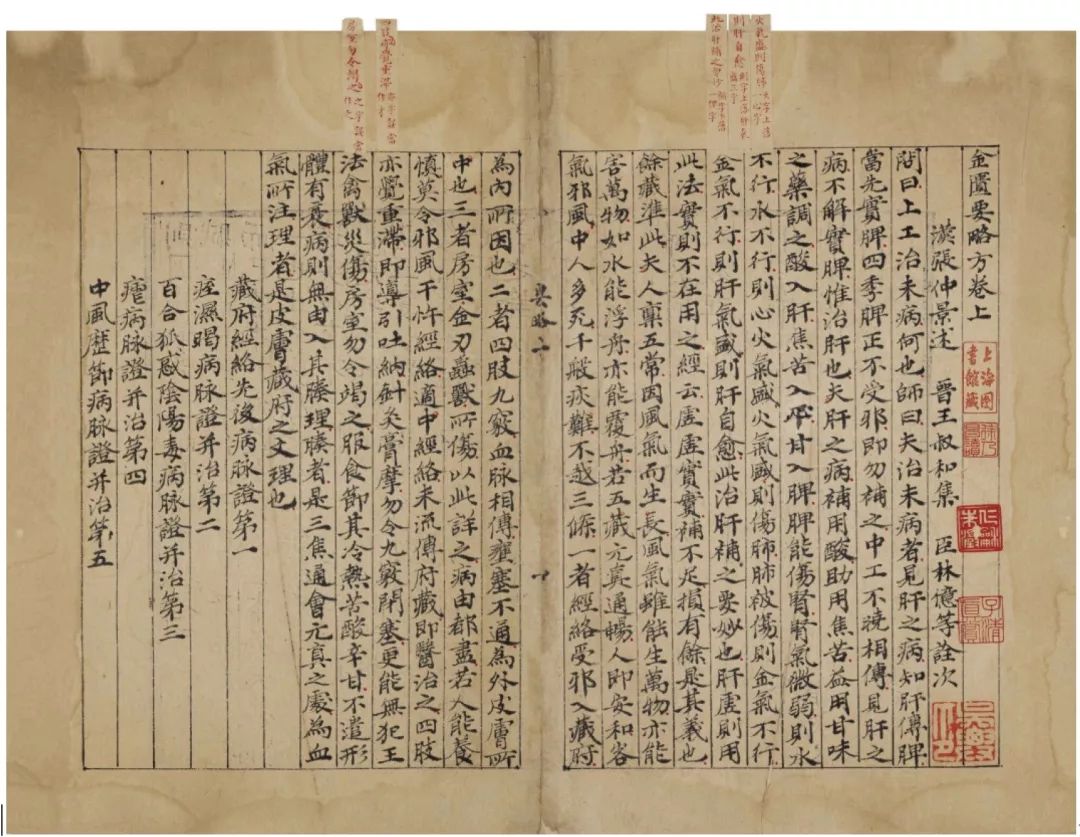
The first page of the Wu Qian copy of “Jingui Yaolue”
Although “Jingui Yaolue” belongs to Zhang Zhongjing’s work, the version of “Jingui Yaolue” that has been passed down is not the ancient version that existed before the Song Dynasty, but rather a significant adaptation made by Song officials based on an old version, and the title was also determined by the Song officials. Therefore, to investigate the correct name of this book, it is unnecessary to trace back to before the Song Dynasty; it can only be determined from the materials of the Song Dynasty.
Inferring from the information contained in various editions
The information contained in various editions refers to the records related to the title in different transmitted versions. By comparing this information with the content of the book, a tendency can be inferred. The texts related to the title of the book in various editions include the following:
First, the current transmitted titles of various editions. The Deng Zhen edition is titled “New Compilation of Jingui Fang Lun”, the Yu Qiao edition is titled “New Compilation of Jingui Yaolue Fang Lun”, the Xu Rong edition is titled “(New Compilation) of Jingui Yuhan Yaolue Fang Lun” (the title of the Xu Rong edition’s first volume includes the words “New Compilation”, but the preface by Lin Yi, the table of contents, and the second and third volumes do not include the words “New Compilation”), the Zhao Kaimei edition is titled “Jingui Yaolue Fang Lun”, and the Wu Qian copy is titled “Jingui Yaolue Fang”: these transmitted titles vary, making it difficult to determine which is the ancient form and which is a transmission change based solely on these titles.
Second, during the Song Dynasty, Gao Baoheng, Sun Qi, and Lin Yi were responsible for organizing “Jingui Yaolue”, and after organizing it, they wrote a preface, which also has different titles, mostly adding the word “Preface” after the title of each transmitted version.
Third, this preface by the Song officials explains the organization process and specifically states: A) the title of the base text; B) the naming after the initial compilation.
Hanlin scholar Wang Zhu, while in the library, found three volumes of Zhongjing’s “Jingui Yuhan Yaolue Fang”, the first discusses febrile diseases, the second discusses miscellaneous diseases, and the third contains formulas and treatments for women… I first edited the treatise on febrile diseases, then edited the “Jingui Yuhan Classic”, and now I have completed this book, arranging the formulas according to the corresponding syndromes… Because the text on febrile diseases is lengthy and abbreviated, the miscellaneous diseases section ultimately ends with dietary prohibitions, totaling twenty-five chapters. After removing duplicates, there are a total of two hundred sixty-two formulas, compiled into three volumes: upper, middle, and lower, still named “Jingui Fang Lun”.
This excerpt is from the Deng Zhen edition, which indicates in the second sentence that the original name of the base text is “Jingui Yuhan Yaolue Fang”, and in the last sentence, it states that the completed book is still named “Jingui Fang Lun”. The Yu Qiao edition, Xu Rong edition, and Zhao Kaimei edition, which belong to the Deng Zhen edition system, are consistent in these two points. The Wu Qian edition also has this preface, but the corresponding part is stated as “still named ‘Jingui Yaolue Fang'”.
Fourth, both the Deng Zhen edition and the Wu Qian edition include a short text after the Song official’s preface, which is somewhat similar to the preface of the “Zhouhou Beiji Fang”. The origin of this text is somewhat abrupt, and it will not be discussed here. In the Deng Zhen edition, this short text is titled “Preface to Jingui Fang Lun”, which states:
Zhongjing’s “Jingui” records nearly a thousand formulas for various diseases, and due to their complexity and redundancy, it is difficult to find what is needed. Therefore, I have traveled throughout the nine provinces, collecting the extraordinary and selecting the essence of various classics to compile a collection of formulas and discussions…
The Yu Qiao edition and Zhao Kaimei edition quote this text in the same manner, but without a title. In the Wu Qian edition, this text is titled “Preface to Jingui Yaolue Fang”, and the last sentence states, “to compile it as an essential collection”. The two versions differ in various aspects.
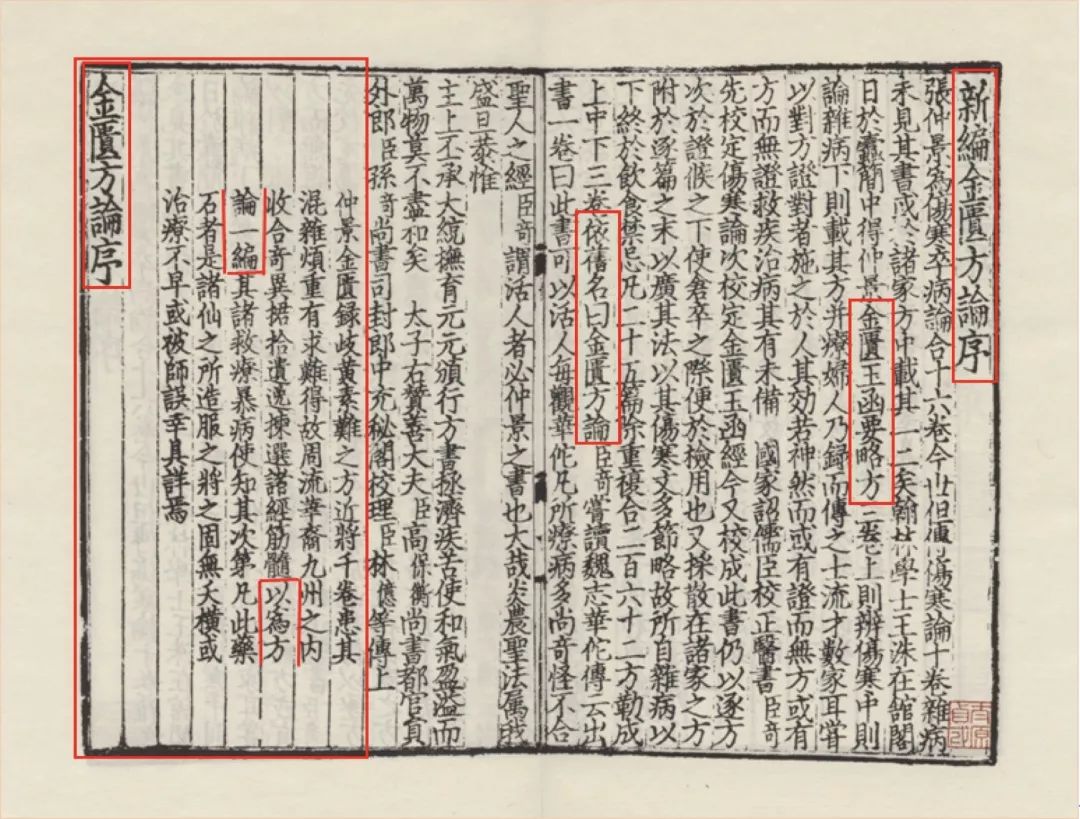
Images of the Song preface and short preface from the Deng Zhen edition
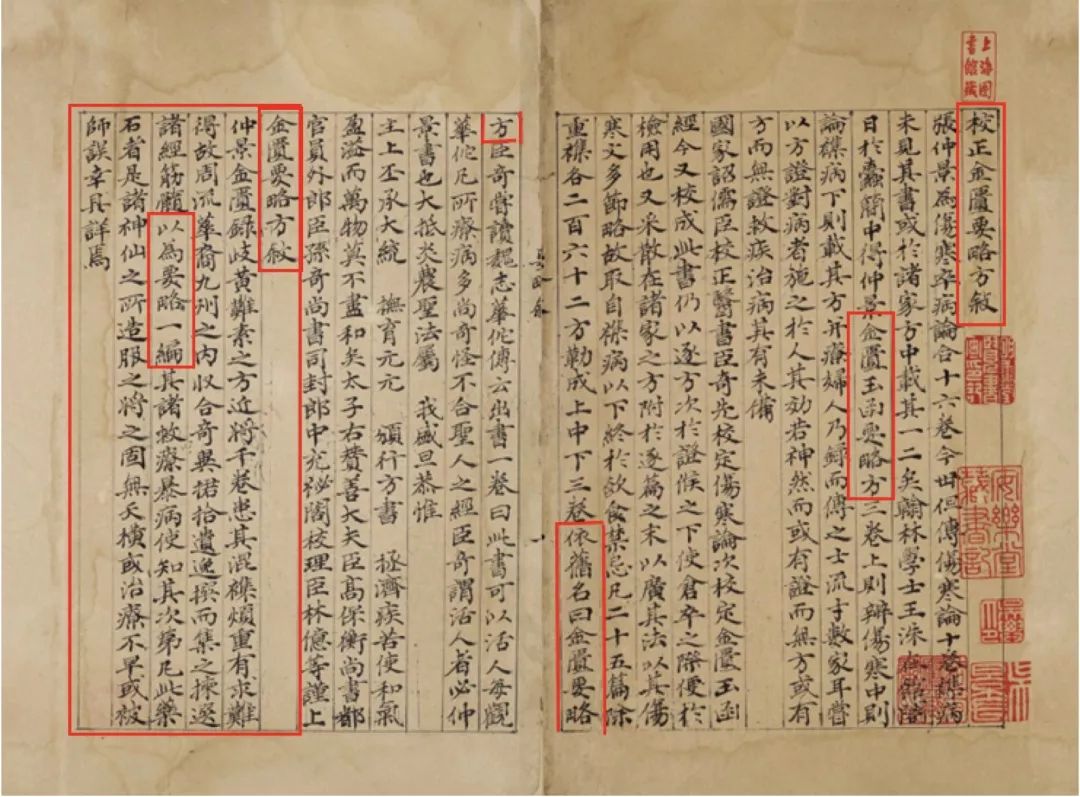
Images of the Song preface and short preface from the Wu Qian edition
By listing the differences among the main transmitted versions:
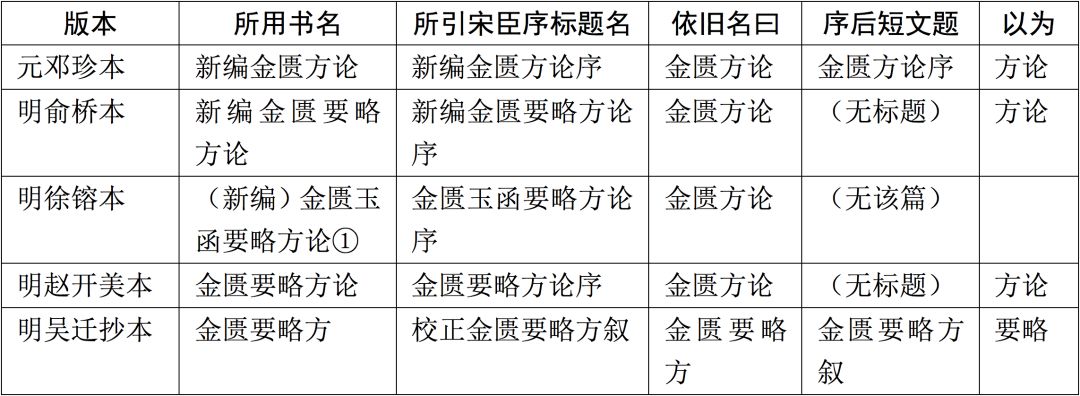
Note: The title of the first volume of the Xu Rong edition includes the words “New Compilation”, but the preface by Lin Yi, the table of contents, and the second and third volumes do not include the words “New Compilation”.
Therefore, although the titles of the Deng Zhen edition system differ, the prefaces also change with the titles, but the content of the prefaces consistently refers to it as “Fang Lun”; further examination shows that although the titles of the various editions in this system differ, the last two characters of the titles are uniformly “Fang Lun”. The Wu Qian edition differs in that both in the preface and the short text, it refers to it as “Yaolue (Fang)” (as seen in the last three columns of the table). The term “Yaolue” does not appear at all in the Deng Zhen edition, but in the other editions of this system, the term “Yaolue” appears in the titles and corresponding preface titles (as seen in the second and third columns of the table).
It is particularly noteworthy that the Deng Zhen edition also contains a preface by Deng Zhen, which has no title, but in the preface, it states: “Song Hanlin scholar Wang Zhu accidentally found three volumes of miscellaneous disease formulas among the worm-eaten manuscripts, titled ‘Jingui Fang Lun’, which is this book.” Deng Zhen clearly knows that the book mentioned in the Song official’s preface is called “Jingui Yuhan Yaolue Fang”, but in his own preface, he still refers to it as “Jingui Fang Lun”, indicating that the title “Jingui Fang Lun” is entirely Deng Zhen’s personal interpretation.
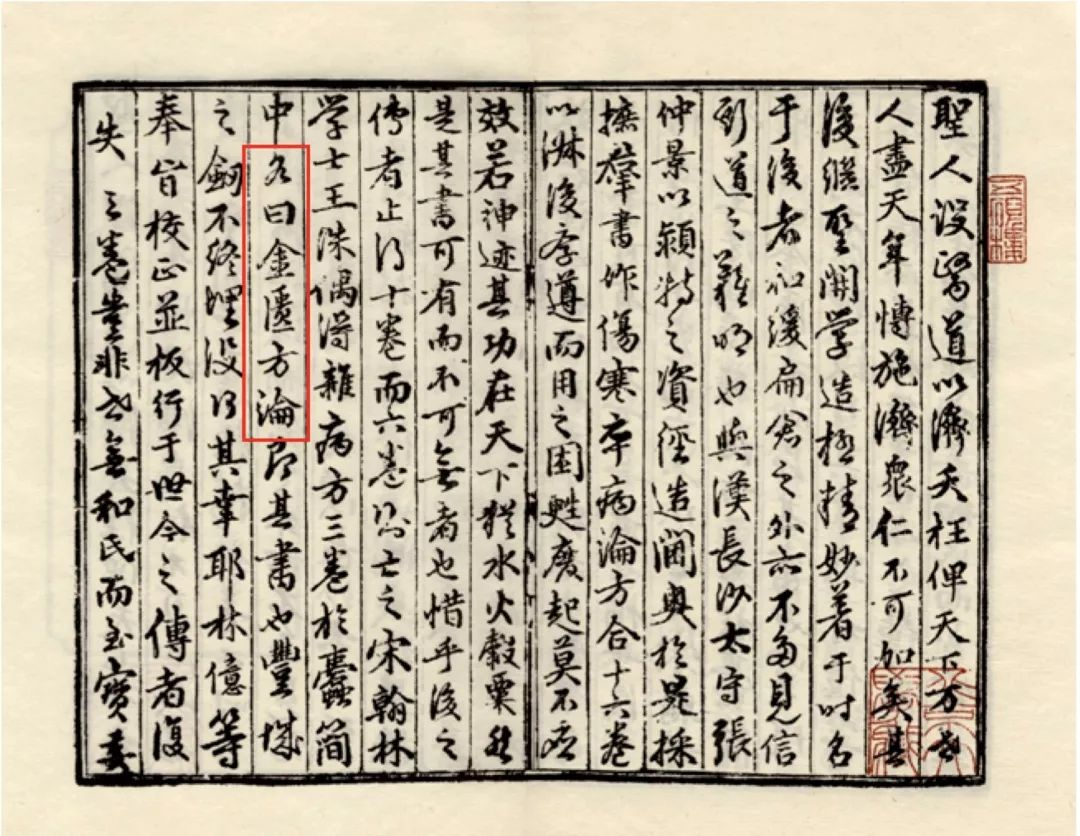
Reviewing the aforementioned Song official’s preface, the basis for the organization of this book is the three volumes of “Jingui Yuhan Fang” discovered by Wang Zhu, which “the first discusses febrile diseases, the second discusses miscellaneous diseases, and the third contains formulas and treatments for women”. The Song officials deleted the content related to febrile diseases and made some additions, then adjusted it to compile the formulas according to the corresponding syndromes, resulting in the book “Jingui Yaolue”. Despite the additions, the content still belongs to the “Yaolue” (essential content), and if it is still referred to as “Jingui Fang Lun”, it would be misleading, as it loses the original book’s characteristic of being an “essential collection” and strays too far from the original title. Therefore, the title must originally have included the term “Yaolue”.
The Yu Qiao edition, Xu Rong edition, and Zhao Kaimei edition, although belonging to the Deng Zhen edition system, all added the term “Yaolue” to the title, possibly stemming from this understanding. Additionally, the aforementioned preface by Zhao Kaimei also quotes the statement in Deng Zhen’s text, but the new title added by Zhao is “Preface to Jingui Yaolue”. It is evident that they also believe that the term “Yaolue” should be included. However, after adding the term “Yaolue”, it leads to a result that is inconsistent with the statement in the Deng Zhen preface, which states “still named ‘Jingui Fang Lun'”.
The title of the Wu Qian edition is only missing the term “Yuhan” compared to the title mentioned in the Song official’s preface, and since “Yuhan” and “Jingui” are essentially synonymous, omitting “Yuhan” results in “Jingui Yaolue Fang”, which aligns with the meaning of “still named”.
From the comparison of the language used in the Deng Zhen edition and the Wu Qian edition, we can infer that the Wu Qian edition is closer to the ancient text and has a higher degree of correctness, thus indirectly suggesting that its title is more credible. For more details, please refer to our article in the first issue of 2019 in the journal “Chinese Medicine Culture”.
However, this is merely a deduction based on comparative advantages or rationality. There is also more important evidence beyond the titles and preface content of the various editions.
Judging from other important historical records
In addition to the various transmitted versions related to the title, there are also some important historical documents that mention this book, which can help in its identification.
One is recorded in the “Song Shu: Yiwen Zhi VI”: “Jingui Yaolue Fang, three volumes (written by Zhang Zhongjing, compiled by Wang Shuhe).” The “Song History” was compiled by Yuan scholars using the existing history of the Song Dynasty, and it basically preserves the original appearance of the Song Dynasty’s official history. Therefore, the title used in the “Song History” should faithfully reflect the name used officially during the Song Dynasty.
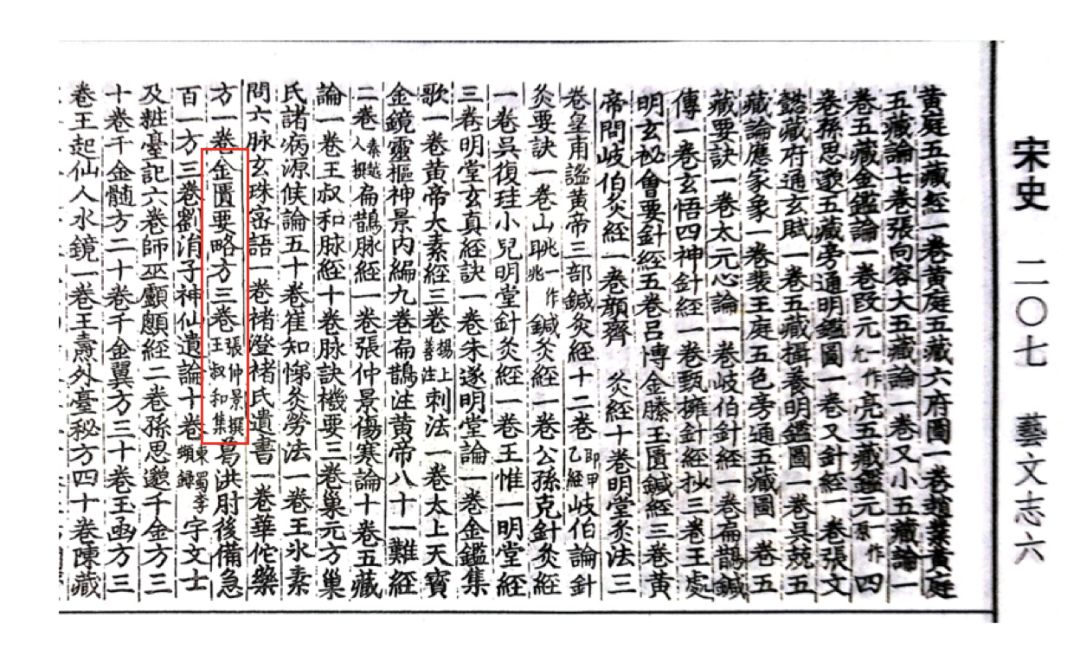
Secondly, there is a document from the Song Dynasty’s Guozijian. In the transmitted “Mai Jing”, there is a preserved document from the Song Dynasty’s Guozijian. The main content of this document states that there was a previous court approval to print small-character editions of five medical books, including “Shenghui Fang”, to facilitate practical use. “Now there are five medical books, including ‘Qianjin Yifang’, ‘Jingui Yaolue Fang’, ‘Wang’s Pulse Classic’, ‘Supplement to the Materia Medica’, and ‘Illustrated Materia Medica’, which are used daily and cannot be lacking. Although this office has seen them printed and sold, they are all large-character editions, and often physicians cannot afford to buy them, especially in remote areas. We request to print small-character editions for re-examination and sale, and to distribute them to remote areas…” This document is also found at the end of the Wu Qian copy of the Northern Song small-character edition of “Jingui Yaolue Fang”. The two can mutually verify each other and together prove that the official title of the book after the Song Dynasty’s editing is indeed “Jingui Yaolue Fang”.
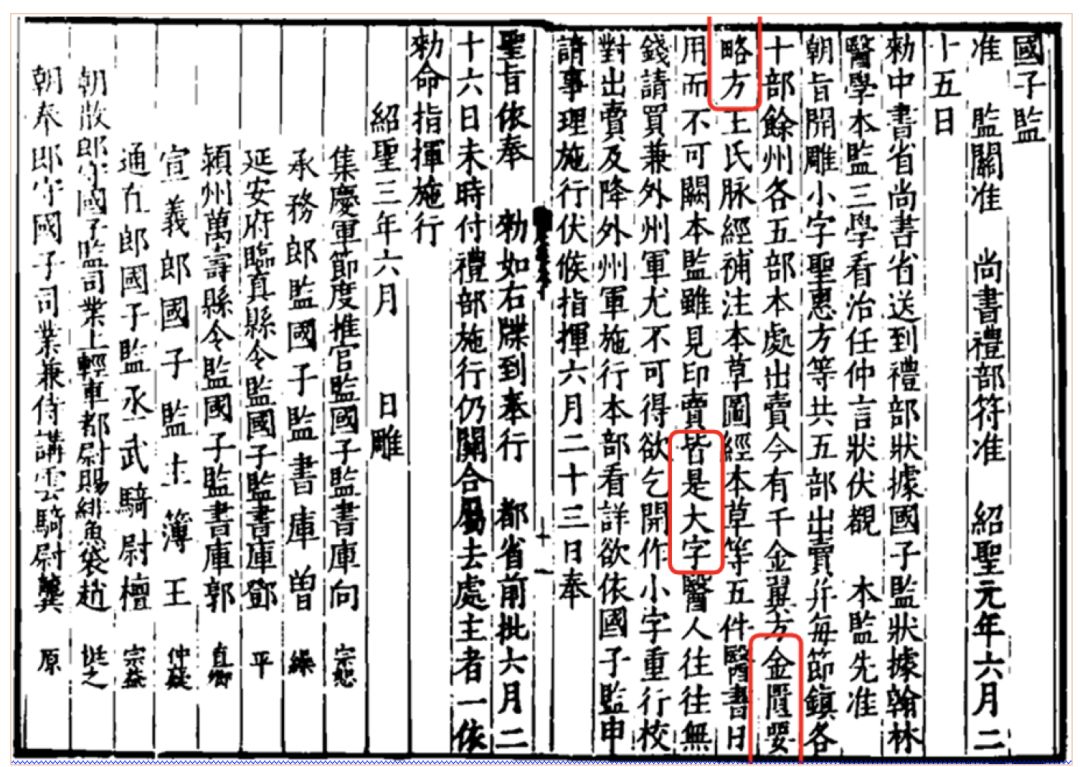
Images of the document from the Song Guozijian preserved in the “Mai Jing”
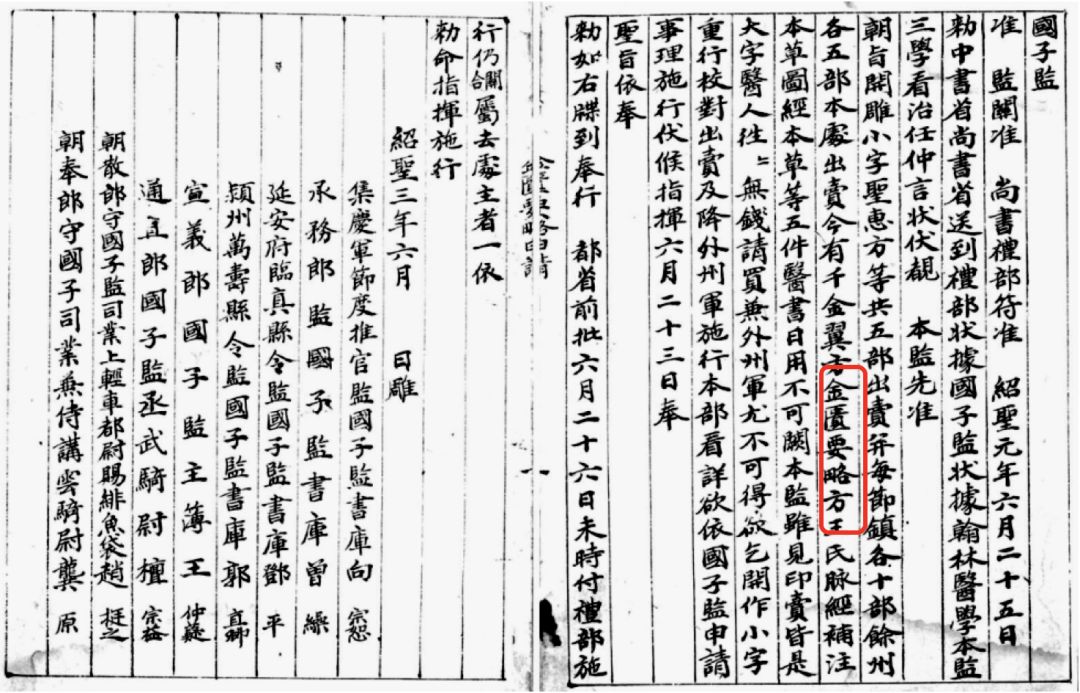
Images of the Wu Qian copy of “Jingui Yaolue” containing the document from the Song Guozijian
Furthermore, a full reading of the Wu Qian copy reveals that it is quite faithful and accurate; the document is a relatively reliable official document. With the support of this document, it can be believed that the title used in the Wu Qian edition, “Jingui Yaolue Fang”, is indeed the initially determined and widely used title of the book.
Is it possible that the large-character and small-character editions used different names? Clearly not. The aforementioned document clearly states that it proposed to print small-character editions of five books, including “Jingui Yaolue Fang”. Therefore, the title of the large-character edition of “Jingui Yaolue” is indeed “Jingui Yaolue Fang”, and the title of the Wu Qian small-character edition is also “Jingui Yaolue Fang”.
Judging from the citations of medical books from the Song and Yuan Dynasties
Using electronic resources to check the citations of “Jingui Yaolue” in ancient books, the following situations can be observed:
First, the most common citation is simply “Jingui”, with approximately a thousand instances. However, the term “Jingui” appears in the titles of all transmitted versions, so it cannot be determined which book it is cited from based on this.
Second, the next most common citation is “Jingui Yaolue”, with several hundred instances. This citation can exclude the “Jingui Fang Lun” of the Deng Zhen edition, but the term “Jingui Yaolue” appears in several other transmitted titles, so it cannot be clearly identified which of these versions it belongs to.
Third, the citation of the Deng Zhen edition’s title “Jingui Fang Lun” (excluding the words “New Compilation”) has about ten instances. The Deng Zhen edition was widely circulated earlier, and in a sense, it can be said that it was the authoritative version of this book from the Southern Song to the early Ming Dynasty, including several instances of citations in the Wu Qian copy that were compared with the Deng Zhen edition. Therefore, such citations are not surprising.
Online resources even reflect that in Yan Yonghe’s “Jisheng Fang”, there is a citation of “Jingui Fang Lun”, and the composition of “Jisheng Fang” predates the Deng Zhen edition. Could it be that the name “Jingui Fang Lun” has an earlier source? However, upon investigation, this is not the case. The composition of “Jisheng Fang” indeed predates the Deng Zhen edition, but the original text has long been lost, and the existing version is a recompiled edition from the Qing Dynasty’s “Siku Quanshu”, and the example involving the title “Jingui Fang Lun” is an annotation under the entry “Maren Pill for Gastrointestinal Disorders” in volume four of this compilation: “The formula is found in the section on difficult bowel movements. Zhang Zhongjing’s ‘Jingui Fang Lun’ uses rice wine to take it. ‘Weisheng Zhibao’ states it as ‘Spleen-Restricting Maren Pill’.” The annotation in the compilation of “Jisheng Fang” should have been made by the Qing Dynasty editors, so the title mentioned in the annotation cannot be counted as part of the content of “Jisheng Fang” (the other book mentioned, “Weisheng Zhibao”, has an uncertain date of composition, with references in the “Yongle Dadian” and early Qing editions, but it is unclear whether it is the same book. The annotation in the “Jisheng Fang” compilation regarding “Weisheng Zhibao” is also uncertain as to whether it comes from the “Yongle Dadian” or the Qing edition).
Fourth, there are very few citations using the title of the Wu Qian edition “Jingui Yaolue Fang”, with fewer than ten instances. However, among them is a citation from Zhang Gao’s “Yishuo” from the Southern Song, which states in volume seven under the entry “Four Seasons Not to Eat”: “‘Jingui Yaolue Fang’ states: In spring, do not eat liver; in summer, do not eat heart; in autumn, do not eat lung; in winter, do not eat kidney; do not eat spleen in all four seasons.” This entry is from “Jingui Yaolue: Prohibitions and Treatments for Birds, Beasts, Fish, and Insects, Chapter Twenty-Four”. The initial draft of “Yishuo” was completed in 1189 and finished in 1224. Among the citations of “Jingui Yaolue”, this is the earliest citation using the full title, and the cited name happens to be “Jingui Yaolue Fang”. Of course, the reason for the rarity of citations using the full title “Jingui Yaolue Fang” is understandable, as ancient people often used abbreviations, and the opportunity to cite a five-character title is inherently less frequent.
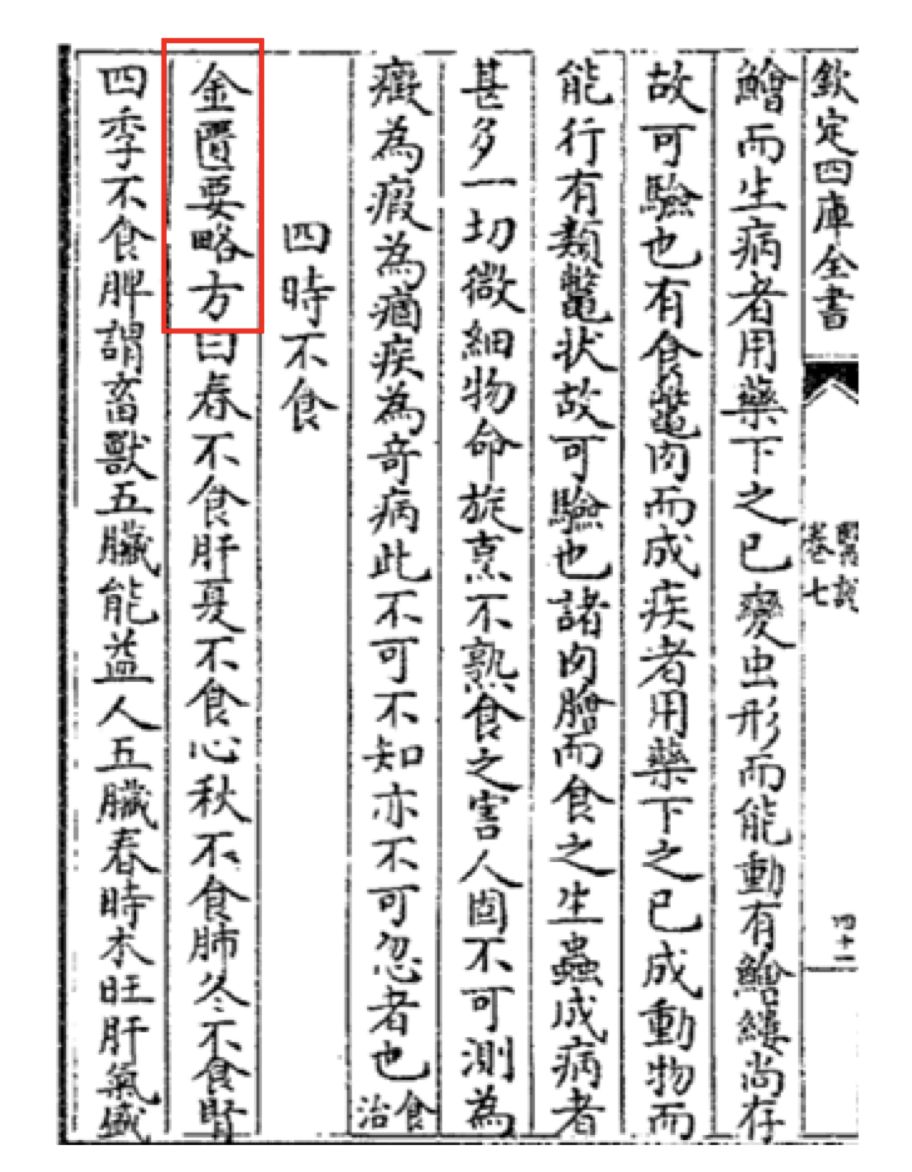
The title used by Zhao Kaimei has six characters, while the titles of the Yu Qiao edition and Xu Rong edition have even more characters. In our online resource checks, there are no instances of the full title of “Jingui Yaolue” being cited in ancient texts before the Ming Dynasty. On one hand, this is certainly because the titles of these three editions are relatively lengthy, making it less likely for ancient people to cite them in full; on the other hand, it also reflects that these titles were likely self-proposed by their respective editors.
In summary, the title determined during the Song Dynasty’s organization of “Jingui Yaolue” is “Jingui Yaolue Fang”; all other titles are redefined by the editors and publishers.
New Media Editor | Luo Naiying


